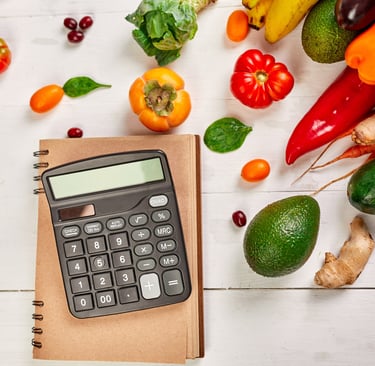Healthy eating on a shoestring
Learn how to achieve healthy eating within a reasonable budget. Check out our 10 tips to maintain a healthy diet and get the nutrients your body needs without breaking the bank.
HABITS AND BEHAVIOUR CHANGEGENERAL HEALTHY EATING AND LIFESTYLE TOPICS
3/24/20246 min read


"Health is expensive"...
...Not if you're doing it right!
I recently attended a Q&A session led by a very well-known person (in their area of special interest) in the wellness industry. I am being deliberately vague so as not to publicly name and shame anyone, but the point is that they have a very large audience that trusts their advice and is likely to follow it without too much question.
Disappointingly, the majority of 'tips and tricks' they provided in this session revolved around purchasing or accessing very expensive equipment rather than achievable actions that the average Joe can start taking immediately to support their own health. Eventually, a couple of participants expressed that they cannot afford these types of things and that they were a little overwhelmed by the numerous suggestions along these lines. The presenter read these comments aloud, stopped, and exclaimed "Well, I'm sorry to say, but health is expensive!"
I was furious.
This is the last thing any health practitioner should be leading anybody to believe. Not only does it provide a great excuse for people not wanting to take accountability for their own health, but it also relegates those with fewer financial means (i.e. those who are ALREADY disadvantaged and tend to experience worse health outcomes on average) to a life of unavoidable sickness.
Now, as a Nutritionist, I KNOW that this comment is completely false. One of the major contributors to the worsening chronic health crisis in modern Western countries is that industries like nutrition have become extremely and unnecessarily overcomplicated. Instead, we would actually do well to go back to the basics of diet from historical times predating the assumption that technology could cancel out poor choices.
It's no wonder people are confused, feel helpless, are struggling with the increasing cost of living, and are unsure where to turn or who to trust.
I don't have all the answers, but I'll tell you this: you are never too financially poor to make positive changes to improve your health. Likewise, no amount of money will improve your health if you are focusing on the wrong things, trying to bypass the foundations.
Yes, healthy food can be expensive, but so can unhealthy food, and most certainly trying to reverse or manage chronic illness can cost a small (or large) fortune.
Often, a few small but targeted behavioural changes can loosen the pinch. Read on for 10 of them (none of which involve any whizbang machines!)
Individual investment in nutrition
During times of financial strain and increasing cost of living, it can be tempting to view the quality of food that we eat as a malleable variable that can be compromised to save money. We pick up a head of broccoli and wonder what it weighs and how much it will cost us, and then turn to the cheese and bacon roll shelf and think that this seems cheaper and will cover more meals.
The perception that healthy foods cost more than unhealthy foods is not necessarily accurate, particularly when you factor in nourishment, satiation, and versatility.
It is also prudent to consider the cost of health issues associated with a poor diet. Nearly half of Australians (47%) are now diagnosed with at least one chronic illness. Those who have one chronic disease spend at least three times more on out-of-pocket healthcare treatment than people with no chronic condition. It stands to reason that those with more than one will incur even greater costs. Chronic illness is largely preventable - and sometimes reversible - through a healthy diet and lifestyle. Given this, it's a no-brainer that these preventative habits are a worthwhile long-term investment for 'future you', especially if you can learn ways to ensure they don't break the bank for 'today you'.
10 tips for saving money on your healthy food bill
Whilst a varied, wholefoods-based diet remains the core strategy for optimal health, in-the-moment cost remains an important consideration for many of us, particularly when on a limited budget.
Luckily, there are ways to maintain a nutritious diet whilst taking care of your bottom line. Food quality, nutrient density, timing and some clever resource management habits are the key to getting the best nutrition bang for your buck.
Below are 10 strategies for affordable healthy eating.
To make your nutrition plan more achievable, I always tackle overcoming these types of on-the-ground challenges with clients.
If you think you could benefit from this support, I'd love to work with you. Reach out today!
10 tips for healthy eating on a budget
Buy local fresh produce in-season
When fruits and vegetables are purchased locally and in-season, they are at their cheapest and most nutritious. This practice also encourages a varied diet that spans the full spectrum of nutrients that fresh produce offers. Buying exotic fruits and vegetables that need to be imported from afar is going to drive up your food bill and subject you to subpar product quality through the nutrient losses that occur during the transport of a long supply chain. Check out Australia's Seasonal Food Guide to plan your yearly consumption.
Get creative with herbs and spices
If you feel bored at the thought of creating a meal with low-cost, nutritious food staples such as lentils, beans, wholegrain rice, and cheap lean cuts of meat, spice up your life with an array of herbs and spices. They can transform even the most bland staples into a taste sensation! Get curious and creative with different flavour combinations, and prepare your own mixes in batches for easy access when cooking future meals.
Note the unit price
In addition to looking at the total price of an item, also take the time to note their unit price (e.g. $ per 100g) to get the best bang for your buck. Buy in bulk where you can. This is especially helpful if it's an item that can be safely stored or frozen for a while.
Take advantage of specials and mark-downs
Consider substituting items in your recipes or meal plans for cheaper but equally nutritious options that happen to be on special. Better still, challenge yourself to select recipes that only include in-season produce that tends to be in surplus and has more chance of being on special during its season.
Plan, plan, plan ahead!
Set a weekly meal plan and write a shopping list to fulfil this plan before hitting the shops. This works in tandem with working with a food budget (see tip below). It also helps to avoid overspending on items that you do not need and those dreaded impulse buys that tend to be unhealthy, anyway.
Grow a green thumb (or at least a few veggies)
If you have the space, consider growing your own fruit and vegetables. There are many upsides that include both financial and health-related benefits of gardening and eating homegrown produce. Even if you only have a small balcony, there are now many resources available online that provide great advice on how to grow fresh produce with limited space.
Don't just plan, also budget
Set a grocery budget and stick to it. This budget should work directly with your prepared meal plan. It may even help to set up a separate bank account dedicated to groceries to help keep track of expenditure throughout your budgeted period, and highlight where you may be overspending. Ensure the significant majority of the budget is dedicated to a variety of wholefoods.
Double up
Cook double, triple or even quadruple batches and freeze leftovers. This tip works in harmony with buying in bulk. True, you may suffer a few nutrient losses through freezing, but this practice can help to reduce food waste and give you quick, healthy meal options when you have less time to cook, providing a net benefit over making poorer choices because you're suddenly low on money or time.
Think local
Hit up nearby local farmers' markets, especially close to closing time. You are not only getting your hands on extremely fresh produce that hasn't travelled halfway across the country (or world!) to reach you for maximum freshness and optimal nutrition, but if you go late in the day you can often grab some great fresh food bargains. Find your closest farmers' market in the Australian Farmers' Markets Association's directory.
Plan some more with meal prep
Cook the majority of your meals at home, and pre-pack and pre-prepare ingredients and meals when possible. This will help to avoid finding excuses to spend money on less healthy meals out or ordering in.
Interested in more content like this?
If you found this content helpful, subscribe to my newsletter today!
Looking for more personalised support?
If you are seeking more personalised professional support to help you establish your goals and develop a wellness plan that is tailored to your unique needs, reach out to me today!
Sources
Australian Institute of Health and Welfare. (2023). Chronic conditions and multimorbidity. [online] Available at: https://www.aihw.gov.au/reports/australias-health/chronic-conditions-and-multimorbidity#common_cc [Accessed 25 Mar. 2024].
Blumfield, M., Starck, C., Keighley, T., Petocz, P., Roesler, A., Abbott, K., Cassettari, T., Marshall, S. and Fayet-Moore, F. (2021). Diet and Economic Modelling to Improve the Quality and Affordability of the Australian Diet for Low and Medium Socioeconomic Households. International Journal of Environmental Research and Public Health, 18(11), p.5771. doi:https://doi.org/10.3390/ijerph18115771.
McRae, I., Yen, L., Jeon, Y.-H., Herath, P.M. and Essue, B. (2013). Multimorbidity is associated with higher out-of-pocket spending: a study of older Australians with multiple chronic conditions. Australian Journal of Primary Health, [online] 19(2), pp.144–149. doi:https://doi.org/10.1071/PY12035.
Wang, S.T.-L., Parkinson, A., Butler, D., Law, H.D., Fanning, V. and Desborough, J. (2022). Real price of health-experiences of out-of-pocket costs in Australia: protocol for a systematic review. BMJ Open, [online] 12(12), p.e065932. doi:https://doi.org/10.1136/bmjopen-2022-065932.
© Sharon Jenner 2024
Location & Contact
Essendon, VIC & Online
Email: hello@intrinsicnutrition.com.au
Phone: 0412 905 582
Subscribe for exclusive content
No spam, I promise!
Just quality content for intrinsic learning and motivation once in a while.


